Art of Banksy transformed into immersive experience in Philly
A 30,000-square-foot retail space in the Fashion District has been transformed into a staged, unauthorized show of work by the secretive street artist.
Listen 1:28
''Banksy Was Here'' occupies a two-story, 30,000-square-foot gallery in the Fashion District mall. (Emma Lee/WHYY)
“Banksy Was Here,” a newly created touring exhibition of work by the famously incognito street artist from England, premieres this weekend in Center City Philadelphia, exactly three months after a previous exhibition “Banksyland” opened for a brief run in Germantown.
“Banksy Was Here” occupies two floors in the Fashion District mall on East Market Street, which previously had been Candytopia. The show was developed by the same companies that produced the popular “Van Gogh: The Immersive Experience”: New York-based Fever and Brussels-based Exhibition Hub.
The Van Gogh attraction is currently on view at the Tower Theater in West Philadelphia, where more than 300,000 people have attended since it opened in 2021, according to executive producer John Zaller.
Zaller chose Philadelphia as the city to debut the immersive Banksy show.

“It embodies Philadelphia for me,” said Zaller. “Philadelphia is one of the hotspots of the early graffiti movement in the United States. It is this lively city where there’s always an incredible appreciation of art, but there’s always a gritty reality to it. Every street corner you turn, there’s something amazing happening.”
“Banksy Was Here” and its Philadelphia predecessor “Banksyland” are not related, other than in subject matter. Both are unauthorized exhibitions in which Banksy, whoever he is, had no direct involvement. At any given time there are several unauthorized Banksy exhibitions bouncing around the world.
The scale of “Banksy Was Here” dwarfs the other shows. It has not quite twice the number of pieces as Banksyland – about 80 compared to 50 – presented in a space about 10 times larger. The show’s 30,000 square feet include theatrically staged rooms, recreations of underground tunnels and concrete bunkers commonly used by graffiti artists, and a salon with virtual reality goggles that take viewers through an animated re-creation of the back alleys of Bristol where Banksy developed his art.

The VR experience is an additional $5 on top of the price of admission, which is on a sliding scale between $33.90 and $37.90 for adults (children $20.90 – $22.90). A VIP ticket is bundled with access to the VR goggles, $42.90 – $49.90.
Much of the work will be familiar to people who have followed Banksy since he came to prominence two decades ago, and likely even to people who have not. The collection of original works, compiled by a dealer in New York, represents the artist’s greatest hits.

There is a stencil of a masked man who appears to be hurling a Molotov cocktail that is actually a bouquet of flowers – here presented as a gilded-framed triptych behind a velvet rope. A girl cradling a bomb. Riot police whose heads are replaced with yellow smiley faces. Lots of rats, a character regarded as a stand-in for the artist himself.
Zaller gives the rats a room to themselves.

“In a lot of cultures the rat is a clever trickster who’s always lurking around the corner, hiding in the dark,” said Zaller. “It references back to the artist himself, but the reference is directly on us, you know, in our struggles every day in the rat race that we’re in right now.”
The exhibition space is so large, the staged galleries sometimes overwhelm the art itself. A Victorian parlor room complete with flocked wallpaper and a fainting couch is relatively sparsely hung with Banksy works that traffic in irony: men crouched in the savannah attack shopping carts with spears, a combat helicopter dons a pink bow, a group of punks line up at a kiosk to buy a t-shirt that reads “Destroy Capitalism.”

Banksy often makes references to his own artistic heroes, including Keith Haring, Basquiat, and Andy Warhol. He skewers popular advertising, like the iconic RCA logo of a dog named Nipper listening to a gramophone, called “His Master Voice.”
In Banksy’s version, “HMV,” the dog points a bazooka to the speaker.
“It forces us to look at our overall societal structure another way,” said Zaller. “We’re so used to the visual image, we’re so used to advertising, we kind of accept things at face value. Banksy doesn’t do that. Looking at his work, it really shifts your perspective a little bit.”
“Banksy Was Here” features a re-creation of a room Banksy made for the Walled Off Hotel, a spoof on the Waldorf Hotel which is an actual boutique hotel operating in Bethlehem in the West Bank. The dining room features tablecloth tables, a wall of security cameras mounted on taxidermy plaques, and a piano out of tune.

“We intentionally left it out of tune,” said Zaller. “It’ll be a lot more fun for people that are playing to tickle the ivories a little bit off-key.”
People are invited to sit on the furniture, play the piano, and try their hand at graffiti in a room with 1500 square feet of blank white wall panels and an array of paint markers.

Just like in the title of the self-produced documentary about Banksy and his critique of the commercialization of the art world, “Exit Through the Gift Shop,” the final room of the exhibition is a gift shop of Banksy-related merchandise for sale.
“Banksy Was Here” is scheduled to run until the end of January, but – like Van Gogh – will be extended if sales prove to be strong. Zaller said Exhibition Hub has leased the space inside the Fashion District well beyond January 2023, with plans to stage more immersive exhibitions that are currently in development.

Saturdays just got more interesting.
WHYY is your source for fact-based, in-depth journalism and information. As a nonprofit organization, we rely on financial support from readers like you. Please give today.






